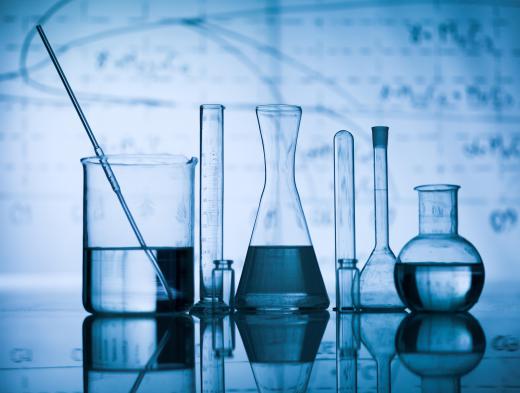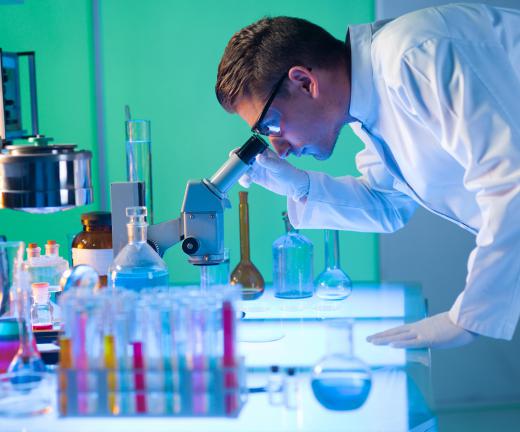What is a Beaker?
 Mary McMahon
Mary McMahon
A beaker is a specialized piece of glassware which is designed to be used in scientific research. You may have worked with a beaker yourself, if you have ever taken a chemistry class. Beakers are cylindrical in shape, with flat bottoms so that that they can be set onto various surfaces, and they typically have a thick lip with a spout to make it easier to pour liquids. There are numerous uses for beakers, making them quite abundant in the scientific community.
It is important to differentiate a beaker and a flask, as these two pieces of glassware are both extensively used in labs, and they are very different. A beaker is a cylinder with flat sides, while a flask has tapered sides which draw close together to create a neck. These pieces of glassware are used somewhat differently, although they are both must-haves in any mad scientist's workspace.

Classically, a beaker is made from glass which has been specially treated to handle rapid temperature changes. Beakers can be placed in situations well below the freezing point, and they can also be rapidly heated without cracking. Some beakers are also designed to resist corrosive materials such as those found in a laboratory, and may have labels which indicate this, often on the bottom of the beaker. In some cases, the special treatment makes a beaker brittle, and it is a good idea to handle beakers with care.

It is also common for a beaker to be marked with volume measurements so that fluids in the beaker can easily be measured. Beakers can be used to store an assortment of fluids, as holding containers for chemical reactions, as mixing tools, and to measure various liquids used in the lab. You may also see people drinking from beakers, echoing the ancient origins of the word “beaker,” which comes from the Latin bicarium, or “drinking vessel.” As a general idea, it is a good idea to keep drinking beakers and experimental beakers separate, for obvious reasons.
Beakers are available from any scientific supply company, while companies which specialize in scientific glassware may offer a range of highly specialized beakers for specific uses. In all cases, beakers are usually designed to go through dishwashers safely, allowing people to sterilize them after each use, reducing the risk of contaminating a chemical reaction or experiment.
AS FEATURED ON:
AS FEATURED ON:












Discussion Comments
This article is interesting, and brought back memories for me of my high school chemistry class. I was not very good in this class, and dropped and broke my share of lab beakers!
Post your comments